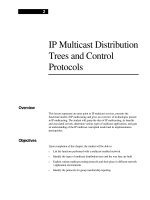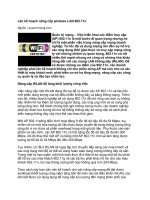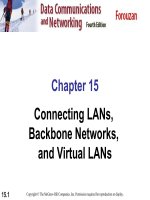Wireless LANs: 802.11 and Mobile IP docx
Bạn đang xem bản rút gọn của tài liệu. Xem và tải ngay bản đầy đủ của tài liệu tại đây (1.49 MB, 100 trang )
Wireless LANs: 802.11 and Mobile IP
Sridhar Iyer
Leena Chandran-Wadia
K R School of Information Technology
IIT Bombay
{sri, leena}@it.iitb.ac.in
/>IIT Bombay ICPWC'02 2
Outline
Overview of wireless networks
–
Single-hop wireless: Cellular, Wireless LANs (WLANs)
–
multiple wireless hops – Mobile ad hoc networks (MANETS)
Challenges of wireless communications
IEEE 802.11
–
spread spectrum and physical layer specification
–
MAC functional specification: DCF mode
•
role in WLANs – infrastructure networks
•
role in MANETs
–
MAC functional specification: PCF mode
Mobile IPv4
Mobile IPv6
IIT Bombay ICPWC'02 3
References
IEEE Computer Society 1999, Wireless LAN MAC
and PHY layer specification
J. Schiller, “Mobile Communications”, Addison
Wesley, 1999. – several figures
Short tutorials on 802.11 and spread spectrum by
J.Zyren, A.Petrick, C.Andren
Mobile IPv4 – RFC 3344 (main)
IPv6 and Mobile IPv6
–
many RFCs, Internet drafts
–
/>IIT Bombay ICPWC'02 4
Overview of
wireless networks
IIT Bombay ICPWC'02 5
Wireless networks
Access computing/communication services, on the move
Cellular Networks
–
traditional base station infrastructure systems
Wireless LANs
–
infrastructure as well as ad-hoc networks possible
–
very flexible within the reception area
–
low bandwidth compared to wired networks (1-10 Mbit/s)
Multihop Ad hoc Networks
–
useful when infrastructure not available, impractical, or expensive
–
military applications, rescue, home networking
IIT Bombay ICPWC'02 6
Cellular Wireless
Single hop wireless connectivity to the wired
world
–
Space divided into cells, and hosts assigned to a cell
–
A base station is responsible for communicating with
hosts/nodes in its cell
–
Mobile hosts can change cells while communicating
–
Hand-off occurs when a mobile host starts
communicating via a new base station
IIT Bombay ICPWC'02 7
Evolution of cellular networks
First-generation: Analog cellular systems (450-900 MHz)
–
Frequency shift keying; FDMA for spectrum sharing
–
NMT (Europe), AMPS (US)
Second-generation: Digital cellular systems (900, 1800
MHz)
–
TDMA/CDMA for spectrum sharing; Circuit switching
–
GSM (Europe), IS-136 (US), PDC (Japan)
–
<9.6kbps data rates
2.5G: Packet switching extensions
–
Digital: GSM to GPRS; Analog: AMPS to CDPD
–
<115kbps data rates
3G: Full-fledged data services
–
High speed, data and Internet services
–
IMT-2000, UMTS
–
<2Mbps data rates
IIT Bombay ICPWC'02 8
Wireless LANs
Infrared (IrDA) or radio links (Wavelan)
Advantages
–
very flexible within the reception area
–
Ad-hoc networks possible
–
(almost) no wiring difficulties
Disadvantages
–
low bandwidth compared to wired networks
–
many proprietary solutions
•
Bluetooth, HiperLAN and IEEE 802.11
IIT Bombay ICPWC'02 9
Wireless LANs vs. Wired LANs
Destination address does not equal destination location
The media impact the design
–
wireless LANs intended to cover reasonable
geographic distances must be built from basic
coverage blocks
Impact of handling mobile (and portable) stations
–
Propagation effects
–
Mobility management
–
Power management
IIT Bombay ICPWC'02 10
Infrastructure vs. Ad hoc WLANs
infrastructure
network
ad-hoc network
AP
AP
AP
wired network
AP: Access Point
Source: Schiller
IIT Bombay ICPWC'02 11
Multi-Hop Wireless
May need to traverse multiple links to reach destination
Mobility causes route changes
IIT Bombay ICPWC'02 12
Mobile Ad Hoc Networks (MANET)
Do not need backbone infrastructure support
Host movement frequent
Topology change frequent
Multi-hop wireless links
Data must be routed via intermediate nodes
A
B
A
B
IIT Bombay ICPWC'02 13
Applications of MANETS
Military - soldiers at Kargil, tanks, planes
Disaster Management – Orissa, Gujarat
Emergency operations – search-and-rescue, police and
firefighters
Sensor networks
Taxicabs and other closed communities
airports, sports stadiums etc. where two or more people
meet and want to exchange documents
Presently MANET applications use 802.11 hardware
Personal area networks - Bluetooth
IIT Bombay ICPWC'02 14
384 Kbps
384 Kbps
56 Kbps
56 Kbps
54 Mbps
54 Mbps
72 Mbps
72 Mbps
5-11 Mbps
5-11 Mbps
1-2 Mbps
1-2 Mbps
802.11
Wireless Technology Landscape
Bluetooth
802.11b
802.11{a,b}
Turbo .11a
Indoor
10 – 30m
IS-95, GSM, CDMA
WCDMA, CDMA2000
Outdoor
50 – 200m
Mid range
outdoor
200m – 4Km
Long range
outdoor
5Km – 20Km
Long distance
com.
20m – 50Km
µwave p-to-p links
.11 p-to-p link
2G
3G
IIT Bombay ICPWC'02 15
Spectrum War: Status today
Enterprise 802.11
Network
Public 802.11Wireless Carrier
Source: Pravin Bhagwat
IIT Bombay ICPWC'02 16
Spectrum War: Evolution
Enterprise 802.11
Network
Public 802.11Wireless Carrier
Market consolidation
Entry of Wireless Carriers
Entry of new players
Footprint growth
Source: Pravin Bhagwat
IIT Bombay ICPWC'02 17
Spectrum War: Steady State
Enterprise 802.11
Network
Public 802.11Wireless Carrier
Virtual Carrier
Emergence of virtual
carriers
Roaming agreements
Source: Pravin Bhagwat
IIT Bombay ICPWC'02 18
802.11 Market Evolution
802.11
Campus
Networking
Mobile user
population
without any
office space
Enterprise
Freedom from
wires for laptop
users;
productivity
enhancement
Industry
Verticals
Medical
Factory floors
Warehouses
Remote data
entry; business
process
efficiency
improvement
Public hotspots
Mobile Operators
Revenue generation
opportunity;
low cost alternative
to GPRS
Broadband access
to home
Untested
proposition;
attempts are on-
going
Source: Pravin Bhagwat
Challenges of
Wireless Communications
IIT Bombay ICPWC'02 20
Wireless Media
Physical layers used in wireless networks
–
have neither absolute nor readily observable boundaries
outside which stations are unable to receive frames
–
are unprotected from outside signals
–
communicate over a medium significantly less reliable
than the cable of a wired network
–
have dynamic topologies
–
lack full connectivity and therefore the assumption
normally made that every station can hear every other
station in a LAN is invalid (i.e., STAs may be “hidden”
from each other)
–
have time varying and asymmetric propagation
properties
IIT Bombay ICPWC'02 21
Limitations of the mobile environment
•
Limitations of the Wireless Network
•
limited communication bandwidth
•
frequent disconnections
•
heterogeneity of fragmented networks
•
Limitations Imposed by Mobility
•
route breakages
•
lack of mobility awareness by system/applications
•
Limitations of the Mobile Device
•
short battery lifetime
•
limited capacities
IIT Bombay ICPWC'02 22
Wireless v/s Wired networks
Regulations of frequencies
–
Limited availability, coordination is required
–
useful frequencies are almost all occupied
Bandwidth and delays
–
Low transmission rates
•
few Kbps to some Mbps.
–
Higher delays
•
several hundred milliseconds
–
Higher loss rates
•
susceptible to interference, e.g., engines, lightning
Always shared medium
–
Lower security, simpler active attacking
–
radio interface accessible for everyone
–
Fake base stations can attract calls from mobile phones
–
secure access mechanisms important
IIT Bombay ICPWC'02 23
Difference Between Wired and
Wireless
If both A and C sense the channel to be idle at the same
time, they send at the same time.
Collision can be detected at sender in Ethernet.
Half-duplex radios in wireless cannot detect collision at
sender.
A
B
C
A
B
C
Ethernet LAN
Wireless LAN
IIT Bombay ICPWC'02 24
–
A and C cannot hear each other.
–
A sends to B, C cannot receive A.
–
C wants to send to B, C senses a “free” medium
(CS fails)
–
Collision occurs at B.
–
A cannot receive the collision (CD fails).
–
A is “hidden” for C.
Hidden Terminal Problem
BA C
IIT Bombay ICPWC'02 25
Exposed Terminal Problem
–
A starts sending to B.
–
C senses carrier, finds medium in use and has to
wait for A->B to end.
–
D is outside the range of A, therefore waiting is not
necessary.
–
A and C are “exposed” terminals
A
B
C
D









